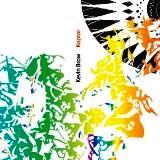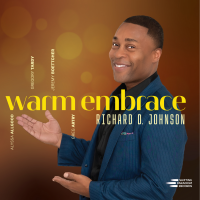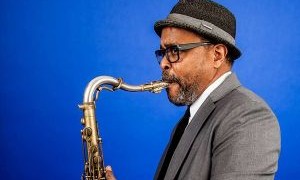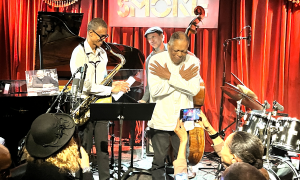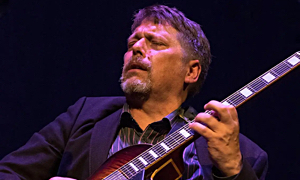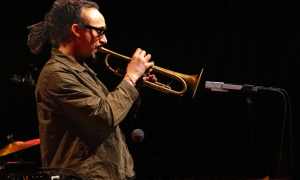Home » Jazz Articles » Live Review » Ottawa Jazz Festival 2008: Days 4-6, June 23-25, 2008
Ottawa Jazz Festival 2008: Days 4-6, June 23-25, 2008
Renaud Garcia-Fons / Corkestra / Lee Konitz
Mimi Fox / Amir Amiri / Berne, Anker, Speed
TD Canada Trust Ottawa International Jazz Festival
Ottawa, Ontario, Canada
June 23-25, 2008
When you run an outdoor festival you're at the mercy of the weather, but one thunderstorm aside, the first three days of the 2008 Ottawa International Jazz Festival (OIJF) managed to beat the poor weather forecast. And while there was some heavy rain on June 24, it cleared up in time for an evening in the park with singer Madeleine Peyroux.
But the inclement weather had no effect on the indoor shows, and festival-goers were treated to a number of outstanding concerts, most notably bassist Renaud Garcia-Fons' evocative afternoon performance at Library and Archives Canada. Chapter Index
- June 23: Renaud Garcia-Fons
- June 23: Corkestra
- June 24: Lee Konitz Trio
- June 25: Mimi Fox
- June 25: Amir Amiri Duo with Linling Hsu
- June 25: Tim Berne/Lotte Anker/Chris Speed
June 23: Renaud Garcia- Fons
It's too easy to simply call Paris-based bassist Renaud Garcia-Fons a virtuoso. Virtuosity, all too often, can mean impeccable technique but a sacrifice of style over substance and skill over emotion. Not so for Garcia-Fons who, with his custom-built five-string double-bass and an equally impressive trio featuring flamenco guitarist Kiko Ruiz and percussionist Pascal Rollando, put on what may be the hottest show at this year's Connoisseur Series. The notes may have been flying fast and furious on occasion, but Garcia-Fons' music is deeply resonant, evocative and emotive. A recent review criticized the bassist for lacking emotional content, but if he heard what the OIJF audience heard, it's more likely that the problem was with him. The trio demonstrated sweeping dynamics, unbridled passion combined with haunting melancholy, and the ability to build tension to a fever pitch, only to let it drop again with such force that members of the audience could be seen literally falling back in their seats.
Performing music from releases including Arcoluz (Enja, 2005) and the captivating Entremundo (Enja, 2004)—an album that set the precedent for an artist who works on many levels, enduring from the get-go but profound enough to reveal more with each listen—the only challenge of the set was, indeed, catching everything that was going on, since there'd be no opportunity to revisit it again. That's the beauty and the demand of any live performance, and while there was, indeed, a lot of information, the lasting impression was one of fervent energy juxtaposed with lyrical beauty and subtle interaction between Garcia-Fons, Ruiz and Rollando.
In the right hands virtuosity is a means to a very musical end, and Garcia-Fons, with a trio approach that more often than not placed his bass front- and-center, changing the conventional and expected complexion of guitar supported by bass and percussion to a trio where a complete whole is created largely without orthodoxy in the delivery. Garcia-Fons did, at times, provide a greater anchor when Ruiz soloed, but roles often reversed, with Ruiz keeping the pulse and harmonic motion moving forward while Garcia-Fons delivered a series of stunning solos that, high energy or low, were always driven by melody and thematic development.
As unconventional an evolution as Garcia-Fons' approach to the bass is, Rollando's percussion set-up was equally unorthodox. Sitting on a large wooden box that acted as his primary instrument—hitting it with hands and brushes—instead of a bass drum he had a large clay pot that was hit with a large, soft floor pedal. A shaker, normally used by hand, was also hooked up to a foot pedal so he could an additional layer without having to sacrifice either of his hands. He rarely soloed—only once, in fact, during the ninety-minute set closer— but when he did it was as well constructed as those of his band mates— impressive, to be sure, but always linked to the core of Garcia-Fons' music.
Ruiz's solos were in the flamenco tradition, but Garcia-Fons' music stretched the boundaries beyond breaking point to include melodies from the Middle East, Africa and India (at one point triggering a sample of a tanpura-like drone), encouraging Ruiz to search beyond the tradition. A powerful rhythmic player, his fluid flow of ideas and strong empathy with Garcia-Fons—they've played together for many years now—created yet another rich layer to absorb.
Garcia-Fons played with the kind of effortless mastery that made everything look easy, even as his remarkable control over the instrument made it possible to extend the potential of his bass, at times, beyond recognition. Occasional but tasteful employment of sound processing made clear that Garcia- Fons, like so many European artists, is keeping up with a modern aesthetic that looks for seamless integration of technology. His arco, in particular, was stunning as he created long, serpentine lines and, at time, evoked the sound of an oud by hitting the strings with his bow rather than tapping them.
While the capacity crowd spoke to popularity that might have seen Garcia-Fons a contender for an outdoor stage headliner at Confederation Park, the intimacy of the 400-seat theater at Library and Archives Canada was a far more suitable venue where, without any outside distractions, it was possible to become completely absorbed in the music of Garcia-Fons and his trio. This was his first appearance in Ottawa; hopefully it won't be his last.
June 23: Corkestra
Dutch pianist Cor Fuhler's Corkestra put on an enthralling performance at the 2007 FIMAV festival in Victoriaville, Quebec, but the version that came to Ottawa for the 2008 OIJF was an augmented version. In addition to the usual—and unusual—line-up of clarinetist Xavier Charles (also seen at Norway's Punkt Festival 2007 with the nascent group Dans Les Arbres, whose first album is already out on ECM in Europe) replacing Ab Baars; saxophonist/clarinetist Tobias Delius; flautist Anne LaBarge; cimbalom (hammered dulcimer) player Nora Mulder; and percussionists Tony Buck and Michael Vatcher, Fuhler added guitarist Andy Moor.
Unfortunately, Moor's contributions were minimal. While AAJ photographer John Fowler commented, during the performance, that "you have to learn the rules before you can break them"—an astute observation about most of Corkestra's players, who all made it clear that, despite their often exaggerated and outr? playing, were well-versed in jazz and classical traditions—Moor was the only player who didn't demonstrate any particular roots in either. Instead, favoring unusual and occasionally provocative sounds—detuning his strings significantly, pulling popping and scratching them—when the nonet began to approach recognizable jazz territory, his contributions felt out of place, insignificant and, at times, distracting.
Still, like the FIMAV performance, there were trademarks of experimentation in the two sets of music all composed by Fuhler. Breaking the group down into subsets at time, most notably for the show's finale—a trio for flute and two clarinets that, in its micro tonality and intensity, maintained the FIMAV review's description of "Ligeti on steroids"—there were plenty of stylistic markers but, as is a part of this Dutch movement that also includes groups like Joost Buis' Astronotes, who delivered a stellar performance at OIJF 2006, virtually all of them were twisted on their sides and filtered through a very odd prism.
Vatcher was a particular treat to watch, at times bowing a large saw, other times playing a set of wine glasses filled with water. A sense of absurdity that's at the core of this Dutch movement was pervasive during much of the performance, with Charles evoking completely foreign sounds from his clarinet, Delius ranging from warm clarinet tones to Ayler-like tenor wails, and LaBarge navigating her series of flutes with remarkable consistency and sonic innovation. De Joode is always a pleasure to hear in any context, capable of surprisingly muscular playing, aggressive strumming and unshakable grooves when (rarely, of course; this is Corkestra after all). required.
Fuhler's compositions follow the lines of directed improvisation— cued arranged segments that act as signposts for free and collective improvisation. Rarely soloing himself, he seemed content to direct the group, pull unusual sounds from the piano through use of a variety of preparatory devices, and interact with Mulder on many occasions.
Perhaps the most abstruse piece was "Wine Cellar," late in the second set. Clearly scored—with Fuhler experimenting inside the piano he attached the chart to the piano cover—it appeared to be a random series of notes and sounds, with little to make it coalesce. With no real resolution, it was a piece that challenged the sizable audience to consider alternate possibilities for what music can be—and, as was the case for most of Corkestra's performance—have fun in the process.
June 24: Lee Konitz Trio
While advertised with a piano-based quartet featuring three Calgary musicians including drummer Sandro Dominelli, festival goers were treated to a surprise line-up that, with the inclusion of drummer Matt Wilson and bassist Martin Wind, turned saxophone legend Lee Konitz's show from what would have undoubtedly been a strong show to a superb one. Local jazz aficionado Gaby Warren, after Konitz's engaging, relaxed but ever-searching trio set, spoke of the trio context being a far better one as it was more intimate and gave Konitz the opportunity to explore further, and he was right. Freed from the piano's inherent harmonic verticality, Konitz, Wind and Wilson were able to stretch five well-known standards to their limits, and then some.
The trio was hanging about the foyer of the Library and Archives Canada theater before its 8:00 PM set, talking about everything from summer tour plans to The Daily Show and The Colbert Report, and that same easy-going, "let's just get together and hang" approach infused the entire set. Playing a saxophone provided by the festival, the octogenarian who looked like he was in his sixties developed an immediate rapport with his audience, saying "I'm pleased to be here...pleased to be anyplace really." After playing the alto for a few moments he said, "I don't know what we're gonna do; this is a Japanese sax, I've never played one before, I play French saxophones."
Well, it wouldn't have mattered if he were using a student horn, the moment he began to play his distinctively warm tone, with just a shade of vibrato, was instantly recognizable. Konitz is known for his free explorations within a largely mainstream/cool context, but what made his Ottawa performance so memorable was how, with familiar material including "Solar" and "I Remember Paris" as a starting point, he managed to twist and turn oftentimes tired songs on their side, his uncannily empathic chemistry with Wind and Wilson keeping things completely accessible. Referring to Iro Haarla's festival show just two days earlier, another festival goer, Sheila Keating, described what moves her as being when an artist looks at the music as a blank canvas, searching for something fresh to paint. It was applicable to Haarla but was just as true for Konitz—all the more remarkable because, in defiance of those who feel that the standards songbook has been mined to its limits, his trio laid such waste to such claims, often in the sparest and most minimal of ways.
"Solar" may have stretched out for well over ten minutes, but it wasn't a series of delineated solos (though there were passages where each of the members came to the fore). Instead, there was a constant push-and-pull and selfless give-and-take that made it and the entire show a true three-way conversation, where the slightest suggestion or nuance from Konitz, Wind or Wilson could push the music into a different direction. Clearly none of them knew how they were going to start or how they were going to end, with Konitz, at the end of one tune, simply stopping and saying to the crowd, "etcetera, etcetera, etcetera." His economical and thoughtful approach to melody maintained a connection with the material, even as he created delicate tension with the slightest hint of atonality.
In keeping with Konitz's approach, Wilson used the smallest kit possible—snare drum, one rack tom, one floor tom, one bass drum, one hi-hat and one cymbal. His keen attention, coupled with a warm sense of humor and ever-present playfulness—a signature that made his own Arts & Crafts group performance at the 2007 OIJF such a stand-out—was the perfect complement to Konitz's own unforced mischievousness. His kit may have been small, but he found more ways to work a single cymbal than most manage with far larger sets. Wilson's remarkable melodicism echoed Konitz's attention to the essence of the material—a rare attribute for a drummer.
Of the three, Wind is the least known, although he's been building a strong reputation playing with artists including Bill Mays, Kate Bull and Don Friedman. He deserves to be better known, however, as he was as effervescent and lighthearted as his trio mates. Impeccable technique, big ears and the ability to evolve a solo from the simplest of ideas—most notably his final solo of the night, the humor of which was picked up by Konitz—made him the trio's unexpected treasure.
In many ways similar to the "playing in a living room" vibe of Chick Corea's 2006 trio show with Eddie Gomez and Airto in nearby Gatineau, Quebec, Konitz's performance may have been brief at just over an hour, but it was proof that, approaching 81, he's still one of the most innovative altoists working in the near-mainstream. Coupled with Wilson's mirthful yet deep interaction and Wind's ability to turn on a dime, it was an unforgettable performance that proves age needn't slow down innovation.
June 25: Mimi Fox
One of the greater challenges facing musicians these days is the cost of touring with a steady group. Travel expenses, often coupled with paperwork and sometimes, as in the case of the United States, exorbitant costs to obtain work permits oftentimes make it difficult or impossible to manage. With CD sales dropping and income from gigging becoming a larger part of the working musician's income, making money on a tour is more important than ever.
The problem, however, is that the musician is at the mercy of the venue/festival and the support artists it provides. Thankfully Ottawa has a strong cadre of players to call upon when the need arises. Guitarist Roddy Elias did an outstanding job at the 2007 OIJF, filling in for Peter Bernstein with Dr. Lonnie Smith, while bassist John Geggie and Ottawa expat drummer Nick Fraser managed the impossible by filling in for bassist Stanley Clarke (appearing this year with the eagerly anticipated Return to Forever), when border problems prevented him from making it to Ottawa for his show with Béla Fleck and Jean-Luc Ponty.
Guitarist Mimi Fox—raised in New York, a San Francisco resident for the past 25 years and who, as she said during one of her casual and entertaining intros at her 4:30PM performance at Library and Archives Canada, "ditched the accent but kept the attitude"—has been touring and picking up rhythm sections as she goes. With Ottawa veteran drummer Bruce Wittet and bassist Norman Glaude, she put on a set heavy on the mainstream but filled with energy, invention and a light-heartedness that was immediately engaging.
With a mix of original material and standards, in particular a beautiful take on "My Romance," where she gave Glaude equal space in a duet setting, Fox proved herself a strong torchbearer for guitar icons like Wes Montgomery and Joe Pass. Her Perpetually Hip (Favored Nations, 2006) provided two views of Fox—one, the democratic, keenly attuned bandleader, the other a fully formed solo artist capable, as she did in performance, of taking The Beatles' richly orchestrated "She's Leaving Home" and capturing all the essential parts with only six strings and two hands. Playing it on a borrowed acoustic guitar from soundman David O'Heare, the guitar as orchestra has rarely sounded so good.
The trio covered a lot of territory, from the opening Latinesque tune that gave Wittet an early opportunity to interact with Fox in a duo setting before Glaude joined in. But it was on Fox's "Blues for Two," written for a longtime musical partner, Harvie Swartz (now just Harvie S), that Glaude and Wittet began to relax and swing with gentle confidence. Fox may sit firmly in the mainstream, but she's developed her own voice, one that includes a curious and unusual intermingling of harmonics with normal picking. Her rich chordal command allowed her to, at times, accompany herself, at other times create hard rhythms for her trio mates to work from.
Fox's relaxed demeanor made it a perfect afternoon performance; much like Lee Konitz's show the previous evening, there was in informal feel that drew the audience in and kept it there for Fox's eighty-minute set.
June 25: Amir Amiri Duo with Linling Hsu
When OIJF Executive Producer began the Improv Series at the National Arts Centre's Fourth Stage, it was a labor of love that allowed her to bring in a handful of artists each year who operate in the outer reaches of the jazz continuum, in addition to some who most might not consider jazz at all. With limitations of time and venue, on two of the evenings O'Grady created unique double bills where, like the old movie theatres of years past, may have had little to connect them, but together created captivating evenings of entertainment that also challenged perceptions of what music can and cannot fit within the jazz continuum. Santour player Amir Amiri's performance, in duet with violinist Linling Hsu, may not have been anywhere close to the traditional neighborhood but, like Cosmos' performance on the festival's second night, was an unexpected treat.
Another engaging artist, Amiri took time between songs to explain the history of his instrument—the santour, which is often mistakenly called a hammered dulcimer, though it does belong in the family, consisting eighteen sets of four strings, each set tuned to the same note. With a three-and-a-half octave range, and tuned a whole note higher than the Iranian version, there was a joke about the 72 strings relating to another significant number and connotation in Islam, but Amiri was quick to joke, "the instrument was around 2500 years before that, so I'm not going to get into it."
The music may have been minor-keyed and, consequently, melancholy for the most part, but the joy on Amiri's face, as he first played solo and then, when brought Hsu out for the rest of the set, on the violinist's face as well, made it clear that this was a duo who truly loved what they were doing. The accuracy required for Amiri to manage the metric cross-patterns, often at a high velocity, was astonishing in itself, as was Hsu's ability to create long, winding melodies on occasion, at other times doubling Amiri note-for-note in astonishing but always beautiful and haunting synchronicity.
Ottawa followers of singer/songwriter Ian Tamblyn will be familiar with the tonality of the santour (though Tamblyn does play an Eastern European hammered dulcimer variant and the music is completely different). Amiri—who has studied in India with Ravi Shankar and plans to study in Spain soon to pursue an interest in Flamenco that was redolent on "Ala Tomatito" in both harmony and structure—largely mines the same nexus between Persian and Indian music that artists like kamancheh master Kayhan Kalhor does on albums including The Wind (ECM, 2006) and those with his longstanding group, Ghazal. Amiri's album (also in duet with Hsu), The Tehran Project (Self Published, 2005), is a strong document of the music heard during his Ottawa performance and, with a capacity crowd that was enthusiastic from the get-go, the santourist's performance was another memorable show for OIJF 2008.
June 25: Tim Berne/Lotte Anker/Chris Speed
During a recent Norwegian trip, Vancouver's Ken Pickering (artistic director of the Coastal Jazz and Blues Society) spoke about festival programming going beyond the more obvious job requirements of creating a balanced line-up and being a project manager to deal with the detailed and often constantly shifting logistics to actually creating groups that may not have existed before, much as ECM Records' Manfred Eicher and Steve Lake have often brought musicians together for the first time, with an instinct for what will work and what won't. Pickering, in fact, has been responsible for a number of interesting collaborations over the years, working with other Canadian festivals to arrange for multi-date tours.
This year OIJF Executive Producer Catherine O'Grady took a major leap into the same territory—she's done this before, but on a smaller scale—by asking renegade saxophonist/composer Tim Berne if he'd be interested in doing a show with fellow saxophonist Lotte Anker, recently heard at FIMAV 2007 in a quartet with Marilyn Crispell, Andrew Cyrille and Mark Helias.
It was an inspired idea, and Berne decided to also enlist clarinetist Chris Speed, another fixture on the New York scene and who created, alongside Berne and Anker, a wind trio that combined rigorous form with broad strokes of freedom.
The music, contributed by everyone, covered a lot of territory but was closer to contemporary classical music in feel, especially when two or three horns came close together for microtonal harmonies that were reminiscent of György Ligeti's work for wind ensembles. Speed was the most visually animated and expressive but, with a performance that was an outstanding combination of near mathematical precision, empathic interaction and individual soloing that, despite the appearance of no parameters (and there were, of course, cases where there were, indeed, few if any), all three transcended one of the trappings of free improvisation—music that seems to be completely random, with no apparent purpose. The trio's entire one hour set was anything but aimless or haphazard, despite there being plenty of opportunities for surprise for everyone.
Despite Berne's rare improvisational acumen, his solos were always clear and focused. Even if the lines the altoist played were abstruse and the tonalities he managed were unique, there was always the feeling that he was working between two destinations. His route may not always have been direct, but there was a pervasive logic and, at times, apparent inevitability. As ever, as the spokesperson for the group, Berne's comments between pieces were dry and witty.
Anker's own arsenal of extended techniques for both tenor and soprano were equally distinctive, at one point passing the mouthpiece of her tenor side to side past her lips to create a breathy expression that, along with some deep, guttural timbres, provided a contrasting texture to Berne. Speed, who played some tenor, but stayed largely with clarinet, is proving to be a writer of no small consequence, something not heard in his work with percussionist John Hollenbeck's outstanding Claudia Quintet but readily apparent at this performance.
It was a demanding concert that asked nearly as much of the audience as it did the members of the trio. But for Berne, Anker and Speed there was an intensity underscored by a certain effortless ability to navigate directed and open-ended improvisations while working together on scored arrangements that forged a unique meeting point along the New Music continuum.
Coming up on days seven and eight of the Ottawa International Jazz Festival: Return to Forever featuring Chick Corea and Charlie Haden Quartet West.
Visit Renaud Garcia-Fons, Corkestra, Mimi Fox, Amir Amiri, Linling Hsu, Tim Berne, Lotte Anker and Ottawa International Jazz Festival on the web.
Photo Credit
John Fowler
Days 1-3 | Days 4-6 | Days 7-8 | Days 10- 11
Tags
PREVIOUS / NEXT
Support All About Jazz
 All About Jazz has been a pillar of jazz since 1995, championing it as an art form and, more importantly, supporting the musicians who make it. Our enduring commitment has made "AAJ" one of the most culturally important websites of its kind, read by hundreds of thousands of fans, musicians and industry figures every month.
All About Jazz has been a pillar of jazz since 1995, championing it as an art form and, more importantly, supporting the musicians who make it. Our enduring commitment has made "AAJ" one of the most culturally important websites of its kind, read by hundreds of thousands of fans, musicians and industry figures every month.



